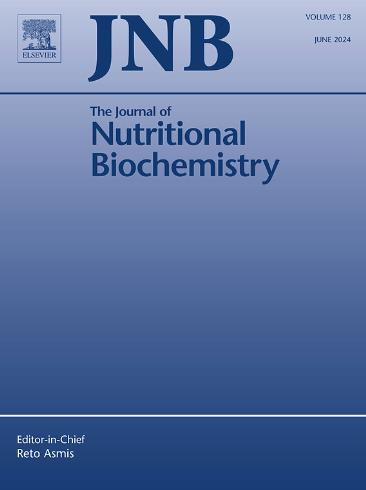基于24小时尿碘排泄的碘摄入不足导致孕妇妊娠早期的显著代谢变化。
IF 4.8
2区 医学
Q1 BIOCHEMISTRY & MOLECULAR BIOLOGY
引用次数: 0
摘要
妊娠早期和中期碘缺乏对孕妇自身及其后代的影响表现出不完全一致的模式。在这项研究中,我们旨在通过使用小分子代谢组学来解决这个问题。共招募了98名孕早期或孕中期的孕妇,收集了基本信息、24小时尿液样本和血液样本,并对其后代的出生结局进行了后续评估。检测24小时尿碘排泄量(UIE),并以此作为判定孕妇碘营养状况的划分标准。采用UHPLC-OE-MS平台进行血清代谢组学分析。采用多元统计分析方法选择差异代谢物作为碘缺乏的潜在生物标志物。关联分析用于进一步分析潜在生物标志物与新生儿出生结局之间的关系。碘摄入不足组与碘摄入充足组孕妇的甲状腺功能指标及新生儿结局无显著差异。然而,与碘充足的孕妇相比,碘不足孕妇的代谢谱明显受到干扰。共筛选出28种不同的代谢物,可作为碘缺乏的潜在生物标志物。调整年龄和妊娠期后,这些生物标志物的表达也发生了显著变化。此外,这些标记还与脂肪酸的生物合成、酪氨酸代谢、色氨酸代谢、花生四烯酸代谢以及戊糖和葡萄糖酸盐的相互转化有关。2-(4-甲基-5-噻唑基)辛酸乙酯与新生儿TSH相关,ACar(12:0), (9S,10E,12Z,15Z)-9-羟基-10,12,15-十八碳三烯酸与体长相关;而(9S,10E,12Z,15Z)-9-羟基-10,12,15-十八碳三烯酸与体重有关。总之,妊娠早期和中期的碘不足不会对孕妇及其后代造成明显的不良影响。然而,在代谢水平上,碘摄入不足可能会破坏孕妇的代谢特征,影响其后代的发育。本文章由计算机程序翻译,如有差异,请以英文原文为准。
Insufficient iodine intake based on 24-h urinary iodine excretion leads to significant metabolic changes in pregnant women at early stages of pregnancy
The effects of iodine insufficiency during the first and second trimesters on both pregnant women themselves and their offspring exhibit insufficient consistent patterns. In this study, we aimed to address this issue by employing small molecule metabolomics. A total of 98 pregnant women in either the first or second trimester were recruited, with comprehensive data including basic information, 24-h urine samples and blood samples collected, and subsequent evaluation of birth outcomes for their offspring. The 24-h urinary iodine excretion (UIE) was detected and used as the dividing criterion to determine the iodine nutrition status of pregnant women. Serum metabolomics was performed by Ultra High Performance Liquid Chromatography Orbitrap Exploris Mass Spectrometry (UHPLC-OE-MS) platform. Differential metabolites as potential iodine deficiency biomarkers were selected by multivariate statistical analysis methods. Association analysis was used to further analyze the relationship between the potential biomarkers and neonatal birth outcomes. There was no significant difference in maternal thyroid function indicators and neonatal outcomes between the insufficient iodine intake group and the iodine adequate pregnant women. However, the metabolic profile of pregnant women with iodine insufficiency was significantly disturbed compared to these with iodine adequate. A total of 28 different metabolites were screened, which could be used as potential biomarkers of iodine deficiency. After adjusted age and pregnancy trimester, the expression of these biomarkers were also changed significantly. Furthermore, these markers were also related to fatty acid biosynthesis, tyrosine metabolism, tryptophan metabolism, arachidonic acid metabolism, and pentose and glucuronate interconversions. In addition, among these markers, 2-(4-Methyl-5-thiazolyl)ethyl octanoate was found to be associated with neonatal TSH, ACar(12:0), (9S,10E,12Z,15Z)-9-Hydroxy-10,12,15-octadecatrienoic acid showed a correlation with body length; whereas (9S,10E,12Z,15Z)-9-Hydroxy-10,12,15-octadecatrienoic acid was linked to body weight. In conclusion, iodine insufficiency during the first and second trimesters dose not result in overt adverse effects on pregnant women and their offspring. However, at the metabolic level, insufficient iodine intake may disrupt the metabolic profile of pregnant women and impact the development of their offspring.
求助全文
通过发布文献求助,成功后即可免费获取论文全文。
去求助
来源期刊

Journal of Nutritional Biochemistry
医学-生化与分子生物学
CiteScore
9.50
自引率
3.60%
发文量
237
审稿时长
68 days
期刊介绍:
Devoted to advancements in nutritional sciences, The Journal of Nutritional Biochemistry presents experimental nutrition research as it relates to: biochemistry, molecular biology, toxicology, or physiology.
Rigorous reviews by an international editorial board of distinguished scientists ensure publication of the most current and key research being conducted in nutrition at the cellular, animal and human level. In addition to its monthly features of critical reviews and research articles, The Journal of Nutritional Biochemistry also periodically publishes emerging issues, experimental methods, and other types of articles.
 求助内容:
求助内容: 应助结果提醒方式:
应助结果提醒方式:


